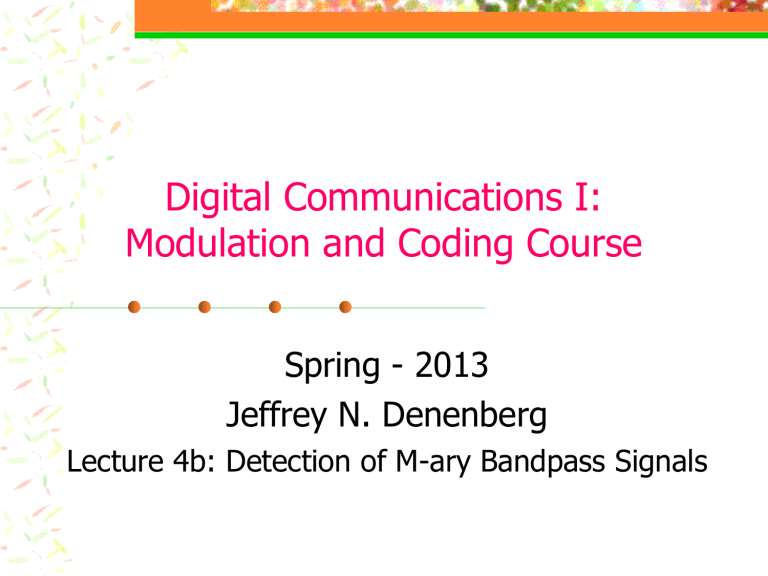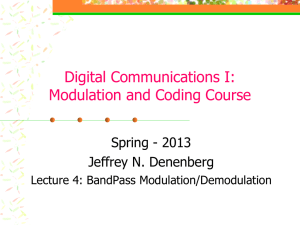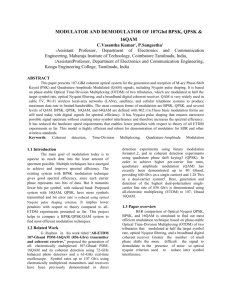Lecture 4b

Digital Communications I:
Modulation and Coding Course
Spring - 2013
Jeffrey N. Denenberg
Lecture 4b: Detection of M-ary Bandpass Signals
Last time we talked about:
Some bandpass modulation schemes
M-PAM, M-PSK, M-FSK, M-QAM
How to perform coherent and noncoherent detection
Lecture 8 2
Example of two dim. modulation s
3
2
( t )
“011”
16QAM
2
( t )
“0000” “0001” “0011” “0010” s
1 s
2
3 s
3 s
4
8PSK
“010” s
4
E s
“1000” “1001” “1011” “1010” s
5 s
6 s
7 s
1
8
-3 -1 1 3 s
9 s
10
-1 s
11 s
“1100” “1101” “1111” “1110”
12
1
( t )
QPSK
“110” s
5
“111” s
6 s
2
“01”
2
( t s
)
7
“00” s
1 s
13 s
14
-3 s
15 s
“0100” “0101” “0111” “0110”
16
“001” s
2 s
“000”
1
1
( t ) s
8
“100”
E s
1
( t )
Lecture 8 s
3 “11”
3
“10” s
4
Today, we are going to talk about:
How to calculate the average probability of symbol error for different modulation schemes that we studied?
How to compare different modulation schemes based on their error performances?
Lecture 8 4
Error probability of bandpass modulation
Before evaluating the error probability, it is important to remember that:
The type of modulation and detection ( coherent or noncoherent) determines the structure of the decision circuits and hence the decision variable, denoted by z
.
The decision variable, z
, is compared with M-1 thresholds, corresponding to M decision regions for detection purposes. r ( t )
1
( t )
N
( t )
T
0
T
0 r
1 r
N
r
N
r
1
r r
Decision
Circuits
Compare z with threshold.
Lecture 8 5
Error probability …
The matched filters output (observation vector= ) is the detector input and the decision variable is a function of , i.e. r z
f ( r )
For MPAM, MQAM and MFSK with coherent detection z
For MPSK with coherent detection z
r
For non-coherent detection (M-FSK and DPSK), z
| r |
r
We know that for calculating the average probability of symbol error, we need to determine
inside i i s i i
Hence, we need to know the statistics of z, which depends on the modulation scheme and the detection type.
Lecture 8 6
Error probability …
AWGN channel model:
r
s i
n s i
a a i 2 a ) iN
The elements of the noise vector are
1 2 N i.i.d Gaussian random variables with zero-mean and
( n
)
1
0
n
N
0
r
( r
1
, r
2
,...,
N
) are independent Gaussian random variables. Its pdf is p r
| i
1
0
s i
0
Lecture 8 7
Error probability …
BPSK and BFSK with coherent detection:
BPSK s
1
“0”
E b
2
( t )
“1”
B
s s
N
0
/ 2
2
1
( t )
E b s
2
1
( t )
BFSK
“0” s
1
E b s s
2
s s s
2
“1”
E b
2
( t )
P
B
b
N
0
P
N
0
Lecture 8 8
Error probability …
Non-coherent detection of BFSK
/ T
)
/ T
)
T
0 r
11
2
Decision variable:
Difference of envelopes z
z
1
z
2 z
1
r
2
11
2 r
12 r ( t )
T
2 t )
T
0 r
12
2
+ z
Decision rule: if ( )
if ( )
T
0 r
21
2
-
T
2 t )
T
0 r
22
2 z
2
2 2
Lecture 8 9
Error probability – cont’d
Non-coherent detection of BFSK …
1
P
B z
1
2
2
)
2
1
2 z
2
| )
1 1 z )
2
z z s
2 2
0 z | , p
2 2
|
2 s
2 2
|
1 2
|
2
)
2 2
P
B
1
2
E exp
2 b
N
0
Rayleigh pdf Rician pdf
Similarly, non-coherent detection of DBPSK
P
B
1 exp
2
E b
N
0
Lecture 8 10
Error probability ….
Coherent detection of M-PAM
Decision variable:
4-PAM
“00” s
1
3 E g
“01” s
2
E g
0 z
r
1
“11” s
3
E g
“10” s
4
1
( t )
3 E g
1
( t ) r ( t )
T
0 r
1
ML detector
(Compare with M-1 thresholds)
Lecture 8 11
Error probability ….
Coherent detection of M-PAM ….
Error happens if the noise, , exceeds in amplitude
1 1 m one-half of the distance between adjacent symbols. For symbols on the border, error can happen only in one direction. Hence:
P
r
m g g
M g
( )
M
M
M
M
g
M
E s
M
M
2
b
3
E g
P
E
M
M log
2
b
0
Lecture 8
p g n
E
M
E
Q
N
0
Gaussian pdf with zero mean and variance
N
0
/ 2
12
r ( t )
Error probability …
Coherent detection of M-QAM s
1
2
( t )
“0000” “0001” “0011” “0010” s
2 s
3 s
4
1
( t )
T
0 r
1
16-QAM
ML detector s
5 s
6 s
7 s
8 s
9
1
( t ) s
10 s
11 s
12
“1100” “1101” “1111” “1110” s
13 s
14 s
15 s
16
“0100” “0101” “0111” “0110”
Parallel-to-serial converter
2
( t )
T
0 r
2
ML detector
Lecture 8 13
Error probability …
Coherent detection of M-QAM …
M-QAM can be viewed as the combination of two
M
PAM modulations on I and Q branches, respectively.
No error occurs if no error is detected on either the I or the Q branch.
Considering the symmetry of the signal space and the orthogonality of the I and Q branches:
( 1
Q and I)Pr(no
E
)
1 log
Q
M
2
E
b
0
Lecture 8
Average probability of
M
14
Error probability …
Coherent detection of MPSK r ( t )
1
( t )
2
( t )
8-PSK
0
T r
1 arctan r
1 r
2
ˆ
T
0 r
2
Lecture 8
“110” s
5 s
4
6 s
3
2
( t )
“011” s
“001”
2
E s s
“000”
1
1
( t ) s
8
“100”
“101” s
7
|
Compute
i
ˆ
|
Decision variable z
r
15
Choose smallest
Error probability …
Coherent detection of MPSK …
The detector compares the phase of observation vector to M-1 thresholds.
Due to the circular symmetry of the signal space, we have:
)
E C
M
where
cos(
0
N
0
2
It can be shown that
(
E
) 2
2 s
N
0
sin or (
E
) 2
2
N
0
Lecture 8 16
Error probability …
Coherent detection of M-FSK r ( t )
1
( t )
M
( t )
T
0
T
0 r
1 r
M
r
M
1 r
r r
ML detector:
Choose the largest element in the observed vector
Lecture 8 17
Error probability …
Coherent detection of M-FSK …
The dimension of the signal space is M . An upper bound for the average symbol error probability can be obtained by using the union bound. Hence:
or, equivalently
( )
E
2
b
N
0
Lecture 8 18
Bit error probability versus symbol error probability
Number of bits per symbol k
log
2
M
For orthogonal M-ary signaling (M-FSK)
P
B
P
E
2
2 k k
1
1
M / 2
M
1 k lim
P
B
P
E
1
2
For M-PSK, M-PAM and M-QAM
P
k
P 1
Lecture 8 19
Probability of symbol error for binary modulation
P
E
Note!
• “The same average symbol energy for different sizes of signal space”
E b
/ N
0 dB
Lecture 8 20
Probability of symbol error for M-PSK
Note!
• “The same average symbol energy for different sizes of signal space” P
E
E b
/ N
0 dB
Lecture 8 21
Probability of symbol error for M-FSK
P
E
Note!
• “The same average symbol energy for different sizes of signal space”
E b
/ N
0 dB
Lecture 8 22
P
E
Probability of symbol error for M-PAM
Note!
• “The same average symbol energy for different sizes of signal space”
E b
/ N
0 dB
Lecture 8 23
P
E
Probability of symbol error for M-
QAM
Note!
• “The same average symbol energy for different sizes of signal space”
E b
/ N
0 dB
Lecture 8 24
Example of samples of matched filter output for some bandpass modulation schemes
Lecture 8 25








